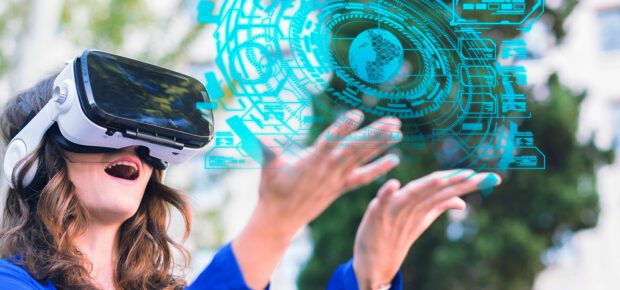April 3, 2024
Maybe you’ve seen the video. A man behind the steering wheel of a moving car. He’s got VR goggles on. And he’s moving his hands as if he’s typing on a keyboard that isn’t there.
Except the keyboard is there – to the guy in the goggles, at least. These sorts of virtual keyboards are the work of spatial computing. It’s a term that’s closely related to augmented reality and the metaverse. Here, IEEE members Todd Richmond and Juan Galindo discuss spatial computing: what it is, what it’s used for and where it’s headed.
“When we use spatial computing, we can engage with computers directly in our surroundings, manipulating virtual objects and information within our physical space,” Galindo said. “This approach requires computers to adapt and understand the human world, rather than the other way around. By doing this, spatial computing aims to seamlessly integrate computers into our lives as natural partners for our daily tasks and activities.”
What is the future of spatial computing, and how could it change our interaction with the digital and physical worlds?
Richmond: To understand the future, it is useful to consider the past. Spatial computing is an evolution of traditional computing, which depends on a screen display. The early mainframes with dumb terminals dictated a very limited set of use cases. As laptop computers began to appear, the ideal of taking digital capabilities anywhere became mainstream. AR and VR were attempts to break free of traditional screen experiences. Experiential design and the user experience for spatial computing don’t have a lot of obvious right answers. It will take time to sort out how we blend the virtual and physical worlds in a way that doesn’t lead to cognitive overload and attention tunneling
What fields are most likely to use spatial computing?
Richmond: If the user experience challenges are solved, spatial computing will be used across academic disciplines and business verticals. Mobile computing is a good analogy – when the iPhone debuted, people asked the same question. Now, 16 years later, it is hard to imagine life without a mobile device. While there were user experience challenges in moving content and experiences to smaller screens, it still was a screen. The core issue with spatial is that the screen goes away – and with it a lot of the design tricks we’ve evolved over the centuries.
What are the key technologies and devices that enable spatial computing?
Richmond: Sensors, network and edge computing are three major technologies. Multi-sensor platforms are critical for gathering information about the local environment – cameras to capture the surroundings as well as movements of the user and others, accelerometers to determine motion, and biometric capabilities to capture heart rate, eye movements, and eventually, the ability to understand user thought and intent. We’re not there yet.
What are the key challenges of spatial computing?
Galindo: The primary challenges are related to ergonomics. Some people feel tired using spatial computing devices, and they will say that the device doesn’t fit well. Another challenge is related to reliability and connectivity. Finally, there are some safety and privacy concerns, as digital identities may be targets for hackers.
What are the big research questions in this field?
Richmond: As spatial computing becomes the norm, our design of the user experiences needs to hold dear the concept that the user is a human – and that ethical design cannot be a nice-to-have but rather is essential for a sustainable and equitable future. This is part of why we have been talking about standing up a new field dedicated to this concept – EI/EX, which stands for equitable interfaces, ethical experiences. These considerations are not optional if we want to have a future that is inclusive and gets us closer to the goal of having technology level the playing field.
What’s Next: How will artificial intelligence, next generation communications, and the metaverse work together? This article from IEEE Xplore provides potential research ideas to guide the work of developers





 Meaningful Momentum or Running in Place?
Meaningful Momentum or Running in Place? AI Through Our Ages
AI Through Our Ages Liquid Infrastructure: Our Planet's Most Precious Resource
Liquid Infrastructure: Our Planet's Most Precious Resource The Impact of Technology in 2025
The Impact of Technology in 2025 Quantum and AI: Safeguards or Threats to Cybersecurity?
Quantum and AI: Safeguards or Threats to Cybersecurity? Why AI Can't Live Without Us
Why AI Can't Live Without Us Bits, Bytes, Buildings and Bridges: Digital-Driven Infrastructure
Bits, Bytes, Buildings and Bridges: Digital-Driven Infrastructure Impact of Technology in 2024
Impact of Technology in 2024 Emerging AI Cybersecurity Challenges and Solutions
Emerging AI Cybersecurity Challenges and Solutions The Skies are Unlimited
The Skies are Unlimited Smart Cities 2030: How Tech is Reshaping Urbanscapes
Smart Cities 2030: How Tech is Reshaping Urbanscapes Impact of Technology 2023
Impact of Technology 2023 Cybersecurity for Life-Changing Innovations
Cybersecurity for Life-Changing Innovations Smarter Wearables Healthier Life
Smarter Wearables Healthier Life Infrastructure In Motion
Infrastructure In Motion The Impact of Tech in 2022 and Beyond
The Impact of Tech in 2022 and Beyond Cybersecurity, Technology and Protecting Our World
Cybersecurity, Technology and Protecting Our World How Technology Helps us Understand Our Health and Wellness
How Technology Helps us Understand Our Health and Wellness The Resilience of Humanity
The Resilience of Humanity Harnessing and Sustaining our Natural Resources
Harnessing and Sustaining our Natural Resources Creating Healthy Spaces Through Technology
Creating Healthy Spaces Through Technology Exceptional Infrastructure Challenges, Technology and Humanity
Exceptional Infrastructure Challenges, Technology and Humanity The Global Impact of IEEE's 802 Standards
The Global Impact of IEEE's 802 Standards Scenes of our Cyber Lives: The Security Threats and Technology Solutions Protecting Us
Scenes of our Cyber Lives: The Security Threats and Technology Solutions Protecting Us How Millennial Parents are Embracing Health and Wellness Technologies for Their Generation Alpha Kids
How Millennial Parents are Embracing Health and Wellness Technologies for Their Generation Alpha Kids Space Exploration, Technology and Our Lives
Space Exploration, Technology and Our Lives Global Innovation and the Environment
Global Innovation and the Environment How Technology, Privacy and Security are Changing Each Other (And Us)
How Technology, Privacy and Security are Changing Each Other (And Us) Find us in booth 31506, LVCC South Hall 3 and experience the Technology Moon Walk
Find us in booth 31506, LVCC South Hall 3 and experience the Technology Moon Walk Virtual and Mixed Reality
Virtual and Mixed Reality How Robots are Improving our Health
How Robots are Improving our Health IEEE Experts and the Robots They are Teaching
IEEE Experts and the Robots They are Teaching See how millennial parents around the world see AI impacting the lives of their tech-infused offspring
See how millennial parents around the world see AI impacting the lives of their tech-infused offspring Take the journey from farm to table and learn how IoT will help us reach the rising demand for food production
Take the journey from farm to table and learn how IoT will help us reach the rising demand for food production Watch technical experts discuss the latest cyber threats
Watch technical experts discuss the latest cyber threats Explore how researchers, teachers, explorers, healthcare and medical professionals use immersive technologies
Explore how researchers, teachers, explorers, healthcare and medical professionals use immersive technologies Follow the timeline to see how Generation AI will be impacted by technology
Follow the timeline to see how Generation AI will be impacted by technology Learn how your IoT data can be used by experiencing a day in a connected life
Learn how your IoT data can be used by experiencing a day in a connected life Listen to technical experts discuss the biggest security threats today
Listen to technical experts discuss the biggest security threats today See how tech has influenced and evolved with the Games
See how tech has influenced and evolved with the Games Enter our virtual home to explore the IoT (Internet of Things) technologies
Enter our virtual home to explore the IoT (Internet of Things) technologies Explore an interactive map showcasing exciting innovations in robotics
Explore an interactive map showcasing exciting innovations in robotics Interactively explore A.I. in recent Hollywood movies
Interactively explore A.I. in recent Hollywood movies Get immersed in technologies that will improve patients' lives
Get immersed in technologies that will improve patients' lives